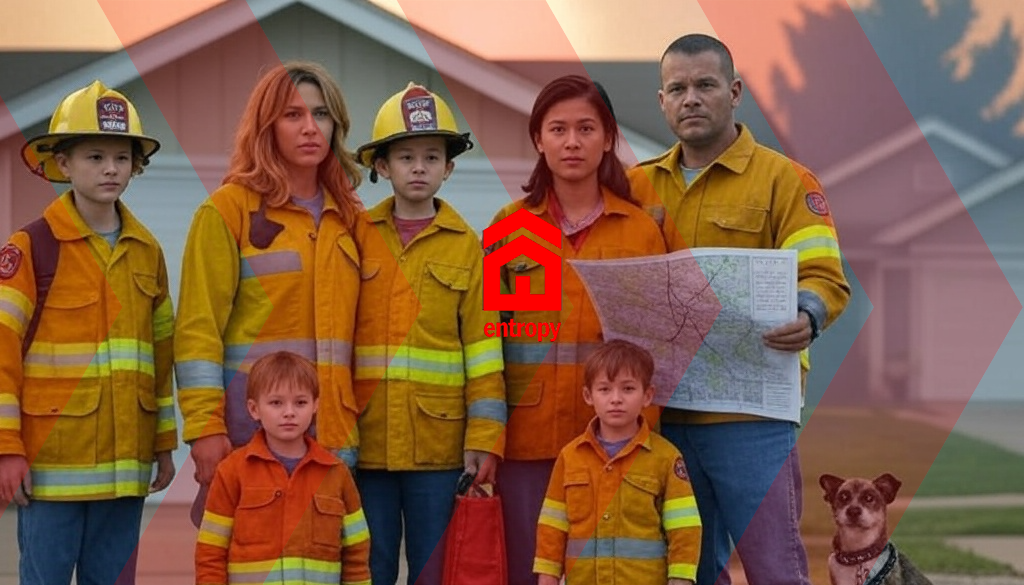Wildfires can start suddenly and spread quickly. If you live in a wildfire-prone area, having a wildfire preparation and evacuation plan for families is not just smart—it’s essential. With the right plan in place, your family can act fast, stay safe, and protect what matters most.
This guide breaks down everything you need to know, in simple steps, to prepare your home, your family, and your go-bag in case of a wildfire emergency.

What Is a Wildfire and Why Should You Be Ready?
A wildfire is an uncontrolled fire that spreads through forests, grasslands, and even neighborhoods. They’re fueled by dry weather, strong winds, and heat—conditions that are becoming more common in many parts of the U.S.
Each year, wildfires destroy thousands of homes and force families to evacuate. But with a plan in place, you can reduce panic and increase your chances of staying safe.
Step 1: Make a Family Emergency Plan
Start by making sure everyone in your household knows what to do if there’s a wildfire. Here’s what your family emergency plan should include:
Meeting Points
- Local meeting spot: A place near your home, like a mailbox or neighbor’s house.
- Out-of-area meeting spot: A friend or family member’s home in a safe area if you have to leave your town.
Communication Plan
- Teach kids how to use phones in emergencies.
- Choose an out-of-state contact everyone can call or text if you get separated.
- Write down key phone numbers and keep them in wallets and go-bags.
Practice Makes Prepared
- Do wildfire evacuation drills twice a year.
- Practice how to leave the house in under 5 minutes.
- Teach kids how to safely leave by foot if roads are blocked.
Step 2: Prepare Your Home Before Fire Season
You can’t stop a wildfire—but you can make your home harder to burn. Use these home fire safety tips:
Defensible Space
Create a “defensible space” by clearing flammable materials:
- Remove dry leaves, dead branches, and pine needles at least 30 feet around your home.
- Trim trees so branches are 10 feet away from your roof.
- Move firewood, propane tanks, and grills at least 30 feet away from buildings.
Fireproof Your Home
- Install spark arresters on chimneys.
- Use fire-resistant roofing and siding if possible.
- Keep hoses connected and test water pressure often.
- Install smoke alarms in every room and test them monthly.
Step 3: Pack a Wildfire Go-Bag
A wildfire evacuation go-bag should be ready to grab in seconds. Keep it in a central spot, and make one for each family member, including pets.
Essentials to Pack:
- Water: At least one gallon per person, per day (3-day supply).
- Food: Easy-to-carry snacks like protein bars and canned goods.
- First Aid Kit: Include bandages, tweezers, antiseptic, and any prescription meds.
- Important Papers: IDs, birth certificates, insurance policies (in waterproof pouch).
- Clothing: Sturdy shoes, long sleeves, face masks, and hats for protection.
- Electronics: Phone charger, power bank, flashlight with extra batteries.
- Cash: Small bills in case ATMs are down.
- Comfort items: Books, toys, or stuffed animals for kids to ease stress.
Don’t Forget Pets!
- Leash and collar with ID tag
- Food and water
- Copy of vet records and recent photo
- Crate or carrier
Step 4: Know When and How to Evacuate
When fire danger is high, don’t wait. Pay close attention to:
- Emergency alerts on TV, radio, or your phone.
- Evacuation levels:
- Level 1 – Be Ready
- Level 2 – Be Set
- Level 3 – GO NOW!
Evacuation Tips:
- Leave early if you feel unsafe, even before being told to evacuate.
- Have multiple routes out of your neighborhood mapped ahead of time.
- Keep a full tank of gas during fire season.
- Pack your go-bags, lock up your home, and bring pets.
- Drive with headlights on and follow official instructions.
Step 5: Create a Wildfire Evacuation Checklist
When a wildfire approaches, stress is high. A checklist can help you act fast and not forget anything.
Wildfire Evacuation Checklist:
- Pack go-bags into the car
- Dress in fire-resistant clothing (long pants, boots, goggles, face mask)
- Shut all windows and doors tightly
- Turn off propane or gas
- Move furniture away from windows
- Leave lights on (helps firefighters see)
- Put a sign on the door: “EVACUATED”
- Load pets and family into the car
- Lock your home and follow your planned route
Step 6: Stay Informed and Calm
During wildfire season, information is power. Sign up for local alerts:
- FEMA App
- Wireless Emergency Alerts (WEA)
- NOAA Weather Radio
- Local fire department social media or websites
Tips for Staying Calm:
- Take deep breaths
- Focus on the next step, not everything at once
- Use calming activities for kids (coloring books, music)
- Remind yourself: you planned for this!
After the Fire: Returning Home Safely
Don’t return home until local officials say it’s safe. When you do:
- Wear a mask and gloves
- Watch for hot spots or smoldering areas
- Check for damaged gas lines or wires
- Take photos of any damage for insurance
Bonus: Wildfire Readiness Tips for Kids
Kids can be part of your wildfire safety team! Help them:
- Learn the sound of a smoke alarm
- Practice how to leave the house in an emergency
- Memorize their full name, address, and one emergency contact
- Help pack their own go-bag with snacks, toys, and clothes
Final Thought: Prepared = Protected
Wildfires are scary—but being prepared makes all the difference. With a wildfire preparation and evacuation plan for families, you give your loved ones a better chance to stay safe, calm, and ready for anything.
Take time to build your plan, practice it, and update your go-bags each season. It’s one of the best ways to protect what truly matters—your family.al is preparation, staying calm, and making informed decisions. By understanding your environment and having the right tools and knowledge, you can greatly increase your chances of making it out safely.
Make sure to check out more articles in our News & Views section. Feel free to reach out any time to see how Entropy Survival can help you prepare you and your family for any disaster or survival scenario.
